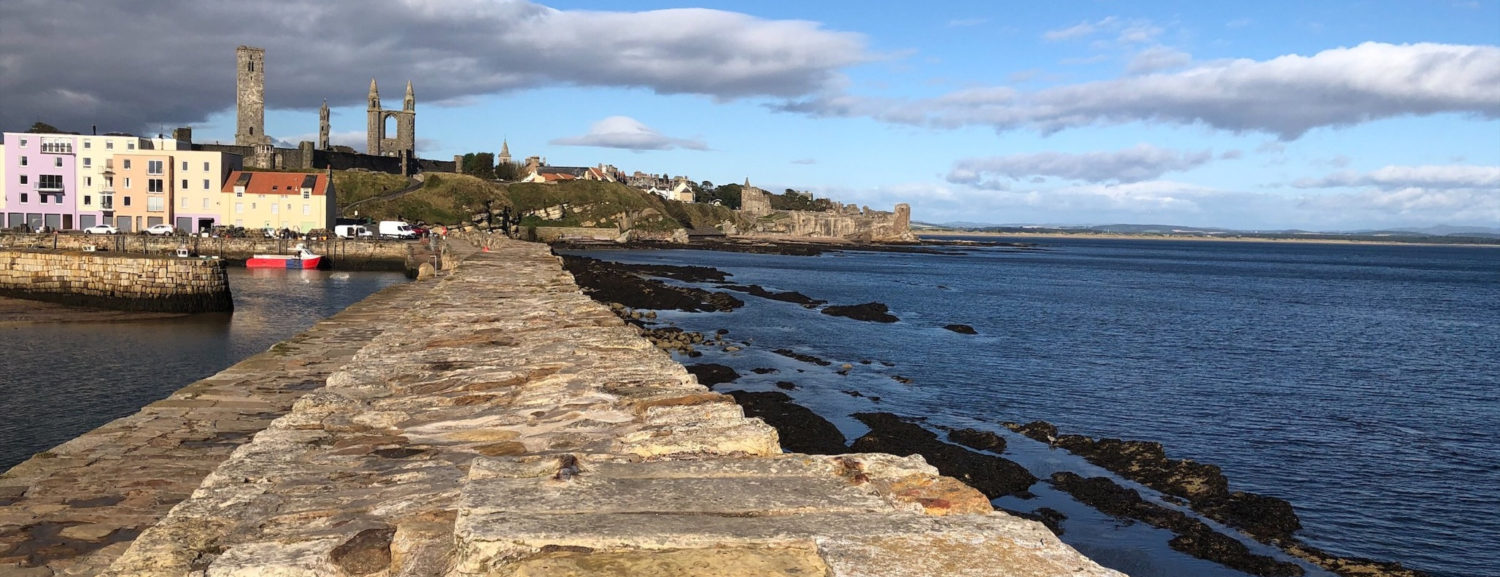Martyrs’ Kirk stands on the site of what was originally Martyrs’ Free Kirk. Built in 1844, the original building was demolished in order to build a bigger church that met the demands of its congregation. This structure, which remains standing to this day, was built between 1925 and 1928 by Gillespie and Scott. However, in 2008 the church was closed and in 2010 the congregation merged with Hope Park Church. The University of St Andrews then acquired the building in 2012 and, after extensive refurbishment, it now serves as a post-graduate study space as well as housing around 5000 volumes of the University’s Special Collections, many of which hold mathematical significance.
The University’s Special Collections has been growing ever since the university was first founded in 1413 and includes an impressive selection of books, photographs, letters, and other documents.
A great number of these artefacts have scientific value. These include, amongst other things, a periodic table of elements from 1885 that is believed to be the oldest such chart in existence, as well as a letter from Charles Darwin to James Forbes (glaciologist and principal of United College), offering up some of the obsidian rocks he collected on Ascension Island for his examination.
Mathematical texts too, are prominent in the Special Collections. Amongst them are some 30,000 documents with connection to D’Arcy Wentworth Thompson (1860-1948). Thompson was Chair of Natural History at the University of St Andrews for over 60 years and is famous for pioneering mathematical biology. He saw and researched the way that nature follows mathematical patterns, such as, for example, the Fibonacci series. Among the documents preserved by the university are a great number of his letters. This includes correspondence with Dorothy Maud Wrinch(mathematician and biochemist), Geoffrey Thomas Bennett (mathematician at Cambridge) and Charles Galton Darwin(physicist and grandson of Charles Darwin). Additionally, there are letters between Thompson and the paleontologist Gerhard Heilmann that would ultimately help form some of the ideas in his most famous work On Growth and Form. As such, these letters help challenge the notion that academically Thompson always worked alone. More info on his collaborations and academic friendships can be found here.
The Special Collections also include two of Thompson’s own annotated copies of On Growth and Form from 1942. These books are especially fascinating, as they include a great number of notes that he added, likely to include in future editions.
Thompson is far from the only mathematician to feature in the Special Collections. Indeed, a great many first editions of important mathematical texts can be found there.
Amongst them is a copy of Mirifici Logarithmorum Canonis Descriptio (A Description of the Wonderful Law of Logarithms) published in 1614, in which John Napier first describes his invention of the logarithm.
Furthermore, two first editions of Isaac Newton’s Naturalis Principia Mathematica, better known as the Principia, are stored there. Published in 1687, only a few hundred copies were initially printed of this text that has fundamentally reshaped our understanding of gravitational force.
Additionally, the Collections include a first edition of Mary Somerville’s Mechanism of the Heavens published in 1831. This translation and reworking of Pierre-Simon Laplace’s Traité de mécanique celeste helped cement her reputation as a well-respected astronomer and mathematician.
Further, a number of first editions of papers by Pierre de Fermat as well as much of his correspondence with other mathematicians can be found there.
Finally, the Special Collections contains a first edition of the mathematician Oliver Byrne’s beautifully illustrated version of Euclid’s Elements (1847). In this, he visually illustrates the mathematical concepts with colourful diagrams and symbols, as opposed to the letters originally used. More information on this unusual text can be found here.
Images of some of the aforementioned texts can be found here.
To further explore the mathematical richness of the Special Collections, click here.
http://www.scottishchurches.org.uk/sites/site/id/4721/name/Martyrs%27+Church+St+Andrews+and+St+Leonards+Fife
https://news.st-andrews.ac.uk/archive/university-to-open-doors-to-martyrs-kirk/
https://special-collections.wp.st-andrews.ac.uk/2017/09/07/maths-week-scotland/
https://news.st-andrews.ac.uk/archive/worlds-oldest-periodic-table-chart-found-in-st-andrews/
https://news.st-andrews.ac.uk/archive/darwin-200-in-st-andrews/
https://special-collections.wp.st-andrews.ac.uk/2019/12/05/darcy-wentworth-thompson-and-his-mathematical-friendships/
https://special-collections.wp.st-andrews.ac.uk/2017/08/22/on-growth-and-form-and-mathematical-biology/
https://special-collections.wp.st-andrews.ac.uk/2014/02/17/treasures-of-the-library-podcast-dr-martin-milner-on-darcy-wentworth-thompsons-personal-copy-of-on-growth-and-form/
https://special-collections.wp.st-andrews.ac.uk/2017/04/04/marvellous-merchiston-400th-anniversary-of-the-death-of-the-mathematician-john-napier-of-merchiston/
https://special-collections.wp.st-andrews.ac.uk/2017/07/05/celebrating-330-years-of-isaac-newtons-principia/
https://special-collections.wp.st-andrews.ac.uk/2016/01/28/reading-the-collections-week-46-math-becomes-art-in-byrnes-1847-colourful-euclid/
